Airport Performance Benchmarking: A Comprehensive Literature Review
VerifiedAdded on 2023/06/05
|6
|1301
|157
Report
AI Summary
This report provides a literature review on airport performance, focusing on the strategic approach of benchmarking. It discusses the increasing pressure to improve airport performance through effective and sustainable management of resources. The review covers key performance indicators, capacity, delays, service levels, safety, and security, all while considering economic costs and benefits. A case study of Imam Khomeini International Airport in Iran is examined, highlighting competitive benchmarking for data collection, quality requirements, and service design. The report also touches on the economic performance of European airports, noting inefficiencies in German airports compared to others. It concludes that benchmarking financial performance and technical efficiency reveals substantial differences among German airports and their international peers, with relatively higher costs and lower productivity in the former.

Task 2: Literature Review
Report
Report
Paraphrase This Document
Need a fresh take? Get an instant paraphrase of this document with our AI Paraphraser
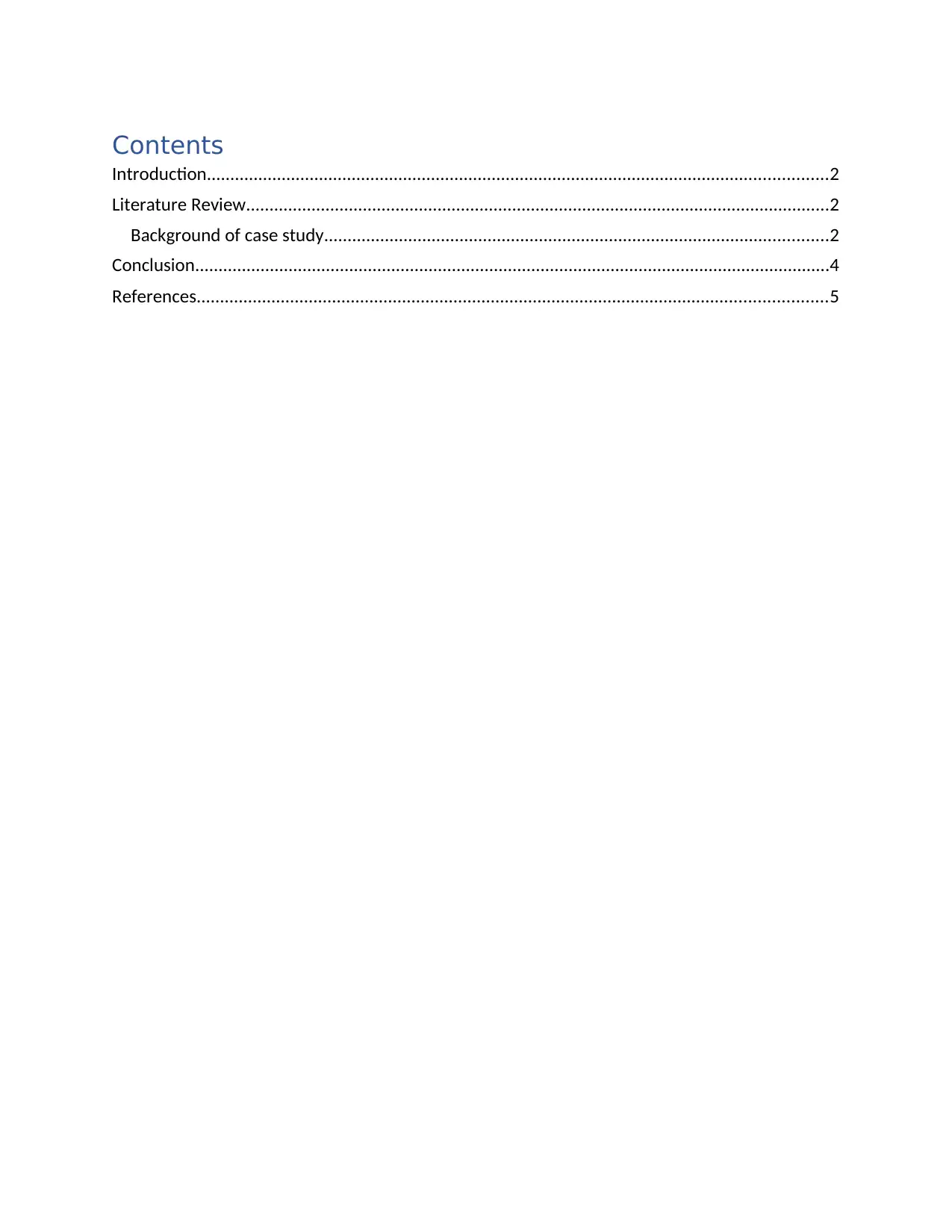
Contents
Introduction.....................................................................................................................................2
Literature Review.............................................................................................................................2
Background of case study............................................................................................................2
Conclusion........................................................................................................................................4
References.......................................................................................................................................5
Introduction.....................................................................................................................................2
Literature Review.............................................................................................................................2
Background of case study............................................................................................................2
Conclusion........................................................................................................................................4
References.......................................................................................................................................5
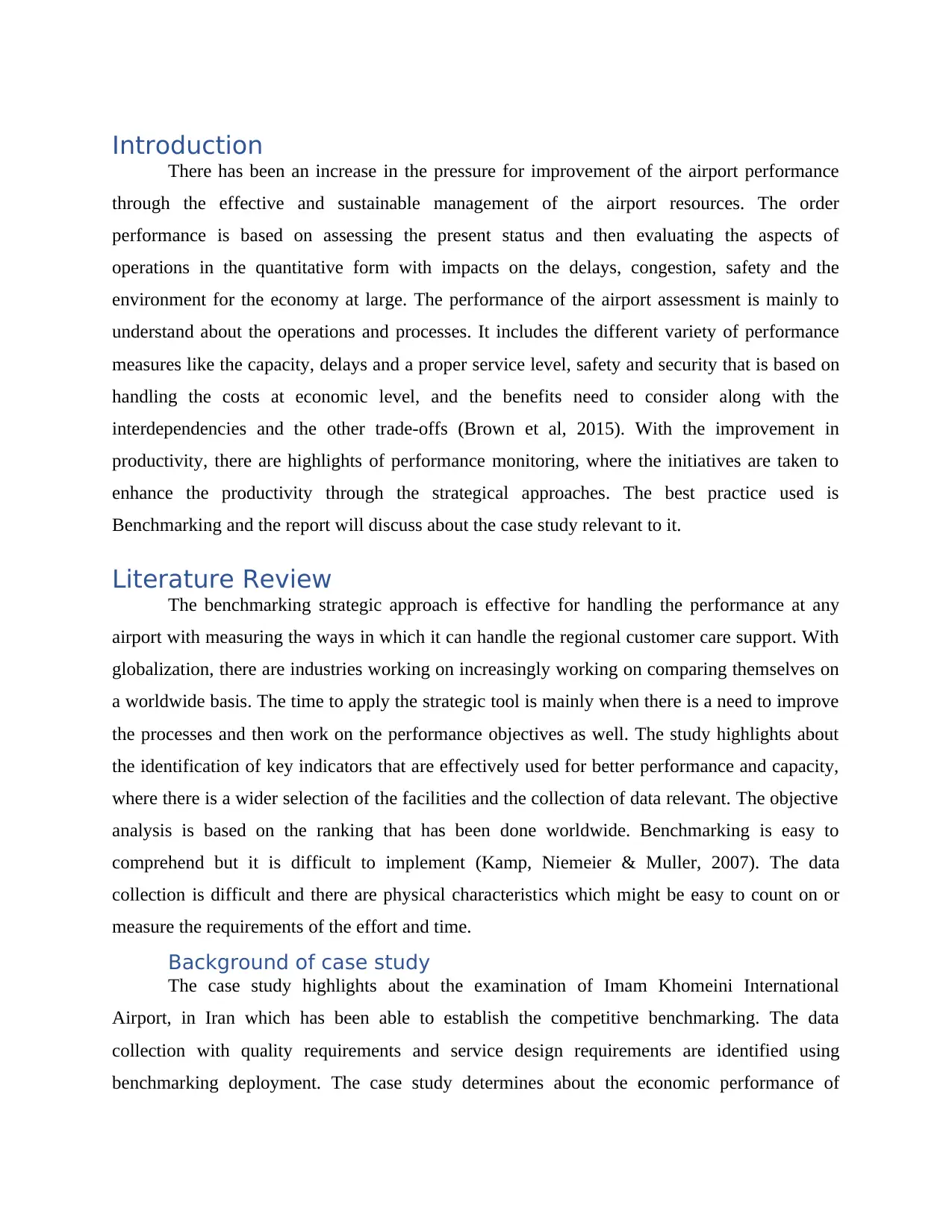
Introduction
There has been an increase in the pressure for improvement of the airport performance
through the effective and sustainable management of the airport resources. The order
performance is based on assessing the present status and then evaluating the aspects of
operations in the quantitative form with impacts on the delays, congestion, safety and the
environment for the economy at large. The performance of the airport assessment is mainly to
understand about the operations and processes. It includes the different variety of performance
measures like the capacity, delays and a proper service level, safety and security that is based on
handling the costs at economic level, and the benefits need to consider along with the
interdependencies and the other trade-offs (Brown et al, 2015). With the improvement in
productivity, there are highlights of performance monitoring, where the initiatives are taken to
enhance the productivity through the strategical approaches. The best practice used is
Benchmarking and the report will discuss about the case study relevant to it.
Literature Review
The benchmarking strategic approach is effective for handling the performance at any
airport with measuring the ways in which it can handle the regional customer care support. With
globalization, there are industries working on increasingly working on comparing themselves on
a worldwide basis. The time to apply the strategic tool is mainly when there is a need to improve
the processes and then work on the performance objectives as well. The study highlights about
the identification of key indicators that are effectively used for better performance and capacity,
where there is a wider selection of the facilities and the collection of data relevant. The objective
analysis is based on the ranking that has been done worldwide. Benchmarking is easy to
comprehend but it is difficult to implement (Kamp, Niemeier & Muller, 2007). The data
collection is difficult and there are physical characteristics which might be easy to count on or
measure the requirements of the effort and time.
Background of case study
The case study highlights about the examination of Imam Khomeini International
Airport, in Iran which has been able to establish the competitive benchmarking. The data
collection with quality requirements and service design requirements are identified using
benchmarking deployment. The case study determines about the economic performance of
There has been an increase in the pressure for improvement of the airport performance
through the effective and sustainable management of the airport resources. The order
performance is based on assessing the present status and then evaluating the aspects of
operations in the quantitative form with impacts on the delays, congestion, safety and the
environment for the economy at large. The performance of the airport assessment is mainly to
understand about the operations and processes. It includes the different variety of performance
measures like the capacity, delays and a proper service level, safety and security that is based on
handling the costs at economic level, and the benefits need to consider along with the
interdependencies and the other trade-offs (Brown et al, 2015). With the improvement in
productivity, there are highlights of performance monitoring, where the initiatives are taken to
enhance the productivity through the strategical approaches. The best practice used is
Benchmarking and the report will discuss about the case study relevant to it.
Literature Review
The benchmarking strategic approach is effective for handling the performance at any
airport with measuring the ways in which it can handle the regional customer care support. With
globalization, there are industries working on increasingly working on comparing themselves on
a worldwide basis. The time to apply the strategic tool is mainly when there is a need to improve
the processes and then work on the performance objectives as well. The study highlights about
the identification of key indicators that are effectively used for better performance and capacity,
where there is a wider selection of the facilities and the collection of data relevant. The objective
analysis is based on the ranking that has been done worldwide. Benchmarking is easy to
comprehend but it is difficult to implement (Kamp, Niemeier & Muller, 2007). The data
collection is difficult and there are physical characteristics which might be easy to count on or
measure the requirements of the effort and time.
Background of case study
The case study highlights about the examination of Imam Khomeini International
Airport, in Iran which has been able to establish the competitive benchmarking. The data
collection with quality requirements and service design requirements are identified using
benchmarking deployment. The case study determines about the economic performance of
⊘ This is a preview!⊘
Do you want full access?
Subscribe today to unlock all pages.

Trusted by 1+ million students worldwide
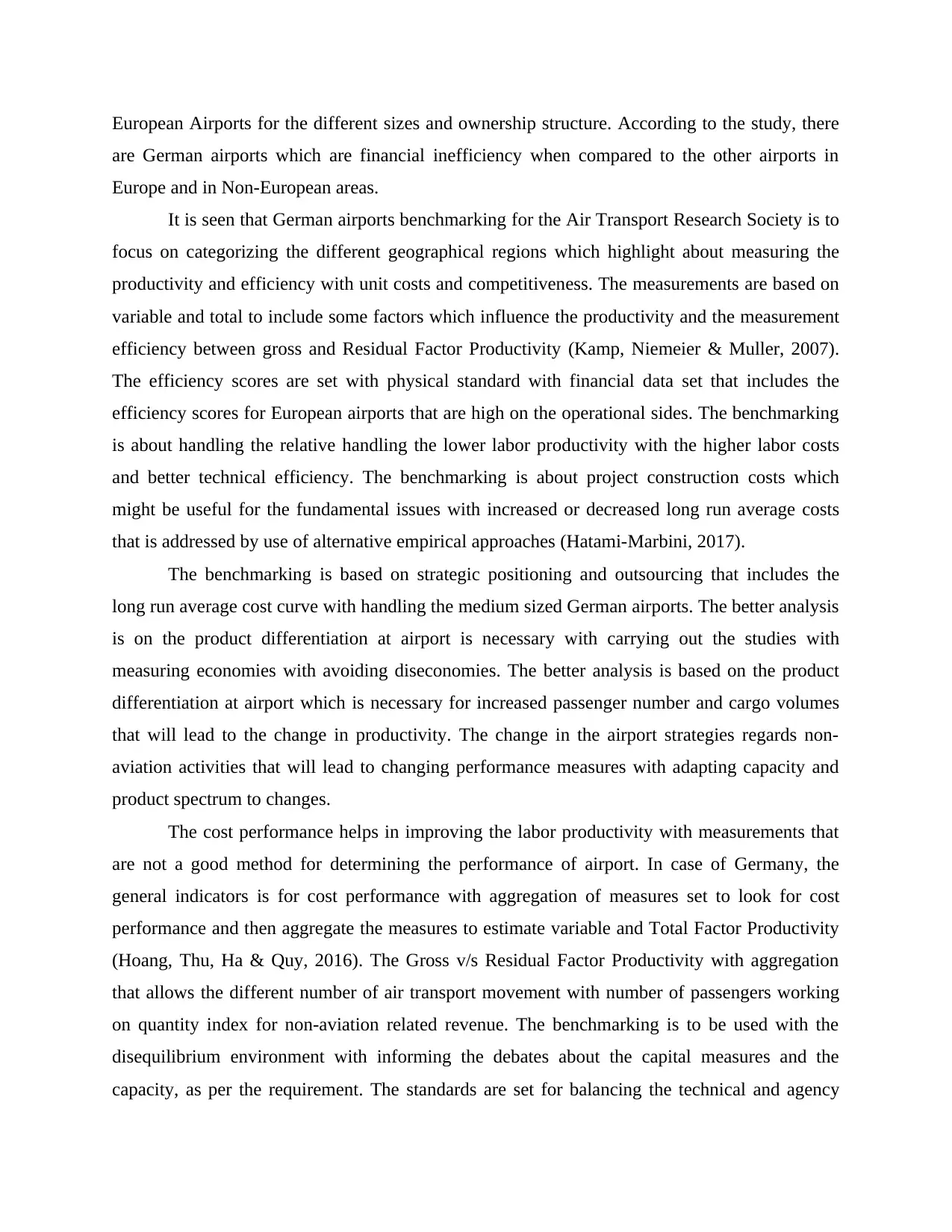
European Airports for the different sizes and ownership structure. According to the study, there
are German airports which are financial inefficiency when compared to the other airports in
Europe and in Non-European areas.
It is seen that German airports benchmarking for the Air Transport Research Society is to
focus on categorizing the different geographical regions which highlight about measuring the
productivity and efficiency with unit costs and competitiveness. The measurements are based on
variable and total to include some factors which influence the productivity and the measurement
efficiency between gross and Residual Factor Productivity (Kamp, Niemeier & Muller, 2007).
The efficiency scores are set with physical standard with financial data set that includes the
efficiency scores for European airports that are high on the operational sides. The benchmarking
is about handling the relative handling the lower labor productivity with the higher labor costs
and better technical efficiency. The benchmarking is about project construction costs which
might be useful for the fundamental issues with increased or decreased long run average costs
that is addressed by use of alternative empirical approaches (Hatami-Marbini, 2017).
The benchmarking is based on strategic positioning and outsourcing that includes the
long run average cost curve with handling the medium sized German airports. The better analysis
is on the product differentiation at airport is necessary with carrying out the studies with
measuring economies with avoiding diseconomies. The better analysis is based on the product
differentiation at airport which is necessary for increased passenger number and cargo volumes
that will lead to the change in productivity. The change in the airport strategies regards non-
aviation activities that will lead to changing performance measures with adapting capacity and
product spectrum to changes.
The cost performance helps in improving the labor productivity with measurements that
are not a good method for determining the performance of airport. In case of Germany, the
general indicators is for cost performance with aggregation of measures set to look for cost
performance and then aggregate the measures to estimate variable and Total Factor Productivity
(Hoang, Thu, Ha & Quy, 2016). The Gross v/s Residual Factor Productivity with aggregation
that allows the different number of air transport movement with number of passengers working
on quantity index for non-aviation related revenue. The benchmarking is to be used with the
disequilibrium environment with informing the debates about the capital measures and the
capacity, as per the requirement. The standards are set for balancing the technical and agency
are German airports which are financial inefficiency when compared to the other airports in
Europe and in Non-European areas.
It is seen that German airports benchmarking for the Air Transport Research Society is to
focus on categorizing the different geographical regions which highlight about measuring the
productivity and efficiency with unit costs and competitiveness. The measurements are based on
variable and total to include some factors which influence the productivity and the measurement
efficiency between gross and Residual Factor Productivity (Kamp, Niemeier & Muller, 2007).
The efficiency scores are set with physical standard with financial data set that includes the
efficiency scores for European airports that are high on the operational sides. The benchmarking
is about handling the relative handling the lower labor productivity with the higher labor costs
and better technical efficiency. The benchmarking is about project construction costs which
might be useful for the fundamental issues with increased or decreased long run average costs
that is addressed by use of alternative empirical approaches (Hatami-Marbini, 2017).
The benchmarking is based on strategic positioning and outsourcing that includes the
long run average cost curve with handling the medium sized German airports. The better analysis
is on the product differentiation at airport is necessary with carrying out the studies with
measuring economies with avoiding diseconomies. The better analysis is based on the product
differentiation at airport which is necessary for increased passenger number and cargo volumes
that will lead to the change in productivity. The change in the airport strategies regards non-
aviation activities that will lead to changing performance measures with adapting capacity and
product spectrum to changes.
The cost performance helps in improving the labor productivity with measurements that
are not a good method for determining the performance of airport. In case of Germany, the
general indicators is for cost performance with aggregation of measures set to look for cost
performance and then aggregate the measures to estimate variable and Total Factor Productivity
(Hoang, Thu, Ha & Quy, 2016). The Gross v/s Residual Factor Productivity with aggregation
that allows the different number of air transport movement with number of passengers working
on quantity index for non-aviation related revenue. The benchmarking is to be used with the
disequilibrium environment with informing the debates about the capital measures and the
capacity, as per the requirement. The standards are set for balancing the technical and agency
Paraphrase This Document
Need a fresh take? Get an instant paraphrase of this document with our AI Paraphraser
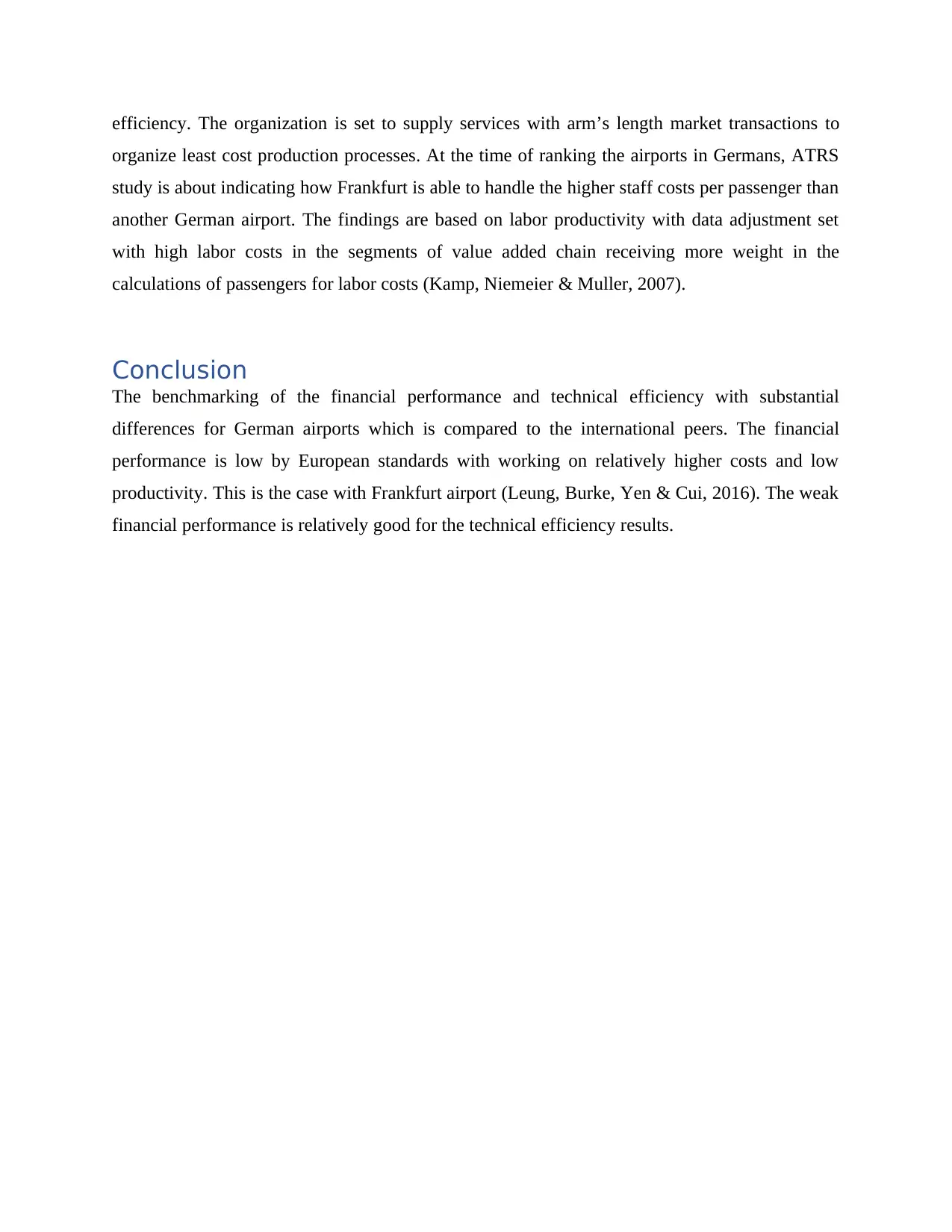
efficiency. The organization is set to supply services with arm’s length market transactions to
organize least cost production processes. At the time of ranking the airports in Germans, ATRS
study is about indicating how Frankfurt is able to handle the higher staff costs per passenger than
another German airport. The findings are based on labor productivity with data adjustment set
with high labor costs in the segments of value added chain receiving more weight in the
calculations of passengers for labor costs (Kamp, Niemeier & Muller, 2007).
Conclusion
The benchmarking of the financial performance and technical efficiency with substantial
differences for German airports which is compared to the international peers. The financial
performance is low by European standards with working on relatively higher costs and low
productivity. This is the case with Frankfurt airport (Leung, Burke, Yen & Cui, 2016). The weak
financial performance is relatively good for the technical efficiency results.
organize least cost production processes. At the time of ranking the airports in Germans, ATRS
study is about indicating how Frankfurt is able to handle the higher staff costs per passenger than
another German airport. The findings are based on labor productivity with data adjustment set
with high labor costs in the segments of value added chain receiving more weight in the
calculations of passengers for labor costs (Kamp, Niemeier & Muller, 2007).
Conclusion
The benchmarking of the financial performance and technical efficiency with substantial
differences for German airports which is compared to the international peers. The financial
performance is low by European standards with working on relatively higher costs and low
productivity. This is the case with Frankfurt airport (Leung, Burke, Yen & Cui, 2016). The weak
financial performance is relatively good for the technical efficiency results.
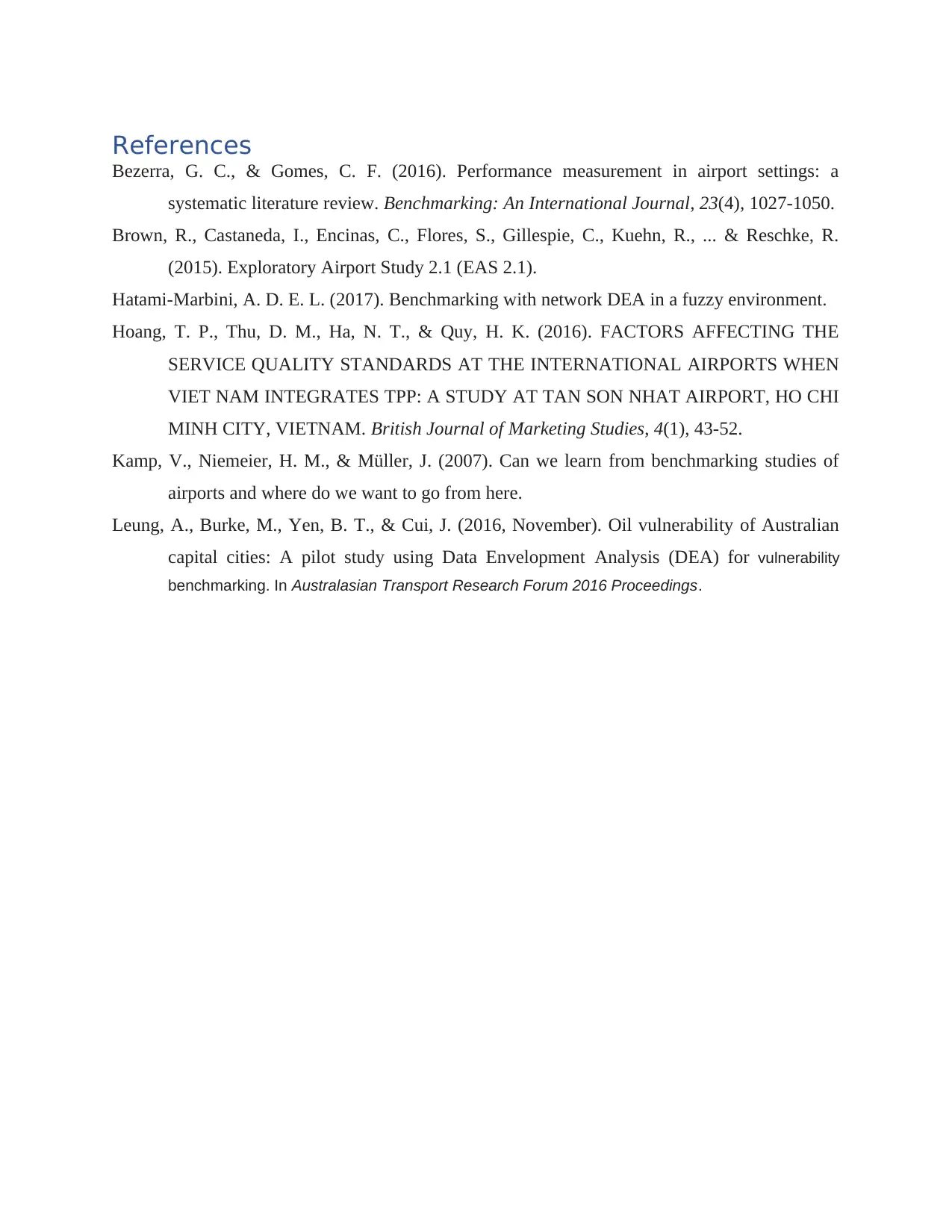
References
Bezerra, G. C., & Gomes, C. F. (2016). Performance measurement in airport settings: a
systematic literature review. Benchmarking: An International Journal, 23(4), 1027-1050.
Brown, R., Castaneda, I., Encinas, C., Flores, S., Gillespie, C., Kuehn, R., ... & Reschke, R.
(2015). Exploratory Airport Study 2.1 (EAS 2.1).
Hatami-Marbini, A. D. E. L. (2017). Benchmarking with network DEA in a fuzzy environment.
Hoang, T. P., Thu, D. M., Ha, N. T., & Quy, H. K. (2016). FACTORS AFFECTING THE
SERVICE QUALITY STANDARDS AT THE INTERNATIONAL AIRPORTS WHEN
VIET NAM INTEGRATES TPP: A STUDY AT TAN SON NHAT AIRPORT, HO CHI
MINH CITY, VIETNAM. British Journal of Marketing Studies, 4(1), 43-52.
Kamp, V., Niemeier, H. M., & Müller, J. (2007). Can we learn from benchmarking studies of
airports and where do we want to go from here.
Leung, A., Burke, M., Yen, B. T., & Cui, J. (2016, November). Oil vulnerability of Australian
capital cities: A pilot study using Data Envelopment Analysis (DEA) for vulnerability
benchmarking. In Australasian Transport Research Forum 2016 Proceedings.
Bezerra, G. C., & Gomes, C. F. (2016). Performance measurement in airport settings: a
systematic literature review. Benchmarking: An International Journal, 23(4), 1027-1050.
Brown, R., Castaneda, I., Encinas, C., Flores, S., Gillespie, C., Kuehn, R., ... & Reschke, R.
(2015). Exploratory Airport Study 2.1 (EAS 2.1).
Hatami-Marbini, A. D. E. L. (2017). Benchmarking with network DEA in a fuzzy environment.
Hoang, T. P., Thu, D. M., Ha, N. T., & Quy, H. K. (2016). FACTORS AFFECTING THE
SERVICE QUALITY STANDARDS AT THE INTERNATIONAL AIRPORTS WHEN
VIET NAM INTEGRATES TPP: A STUDY AT TAN SON NHAT AIRPORT, HO CHI
MINH CITY, VIETNAM. British Journal of Marketing Studies, 4(1), 43-52.
Kamp, V., Niemeier, H. M., & Müller, J. (2007). Can we learn from benchmarking studies of
airports and where do we want to go from here.
Leung, A., Burke, M., Yen, B. T., & Cui, J. (2016, November). Oil vulnerability of Australian
capital cities: A pilot study using Data Envelopment Analysis (DEA) for vulnerability
benchmarking. In Australasian Transport Research Forum 2016 Proceedings.
⊘ This is a preview!⊘
Do you want full access?
Subscribe today to unlock all pages.

Trusted by 1+ million students worldwide
1 out of 6
Your All-in-One AI-Powered Toolkit for Academic Success.
+13062052269
info@desklib.com
Available 24*7 on WhatsApp / Email
![[object Object]](/_next/static/media/star-bottom.7253800d.svg)
Unlock your academic potential
Copyright © 2020–2025 A2Z Services. All Rights Reserved. Developed and managed by ZUCOL.

